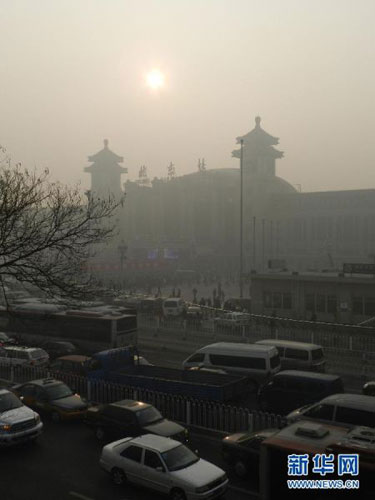PM2.5: a gauge easy to monitor but hard to control

Over 100 flights were canceled or delayed Tuesday morning as a thick haze enveloped Beijing, China's capital city currently embroiled in a fierce public debate over the air-quality monitoring gauge PM2.5.
Despite forthcoming tighter monitoring standards nationwide, it is no easy task for Beijing and other cities to implement PM2.5 standards and then further control pollution, insiders have said.
Particles 2.5 microns or less in diameter (PM2.5) are referred to as "fine" particles and are believed to pose greater health risks than larger particles because they can embed deep in people's lungs.
Easing air pollution in China during its development phase is a massive systematic project, said Hao Jiming, director of the Institute of Environmental Sciences and Engineering at Tsinghua University.
"It is estimated to take at least 10 years for Beijing to meet the upcoming national standards under the PM2.5 gauge," Hao said, adding that the process is bound to kick off a long, brutal fight.
The public debate on PM2.5 and PM10 first began when it came to light that air-quality monitoring results released by Beijing's weather forecasting station and the U.S. Embassy in Beijing often differed.
While the embassy's results often described Beijing's air quality as "hazardous" or "dangerous," the Beijing weather forecasting station would classify the pollution as "minor." Both sources defended their stances by saying that the divergence resulted from using different measurement standards.
China currently uses PM10, or particulate matter under 10 microns, to measure air quality -- a measure often seen as the root of discrepancies between the government's ratings and the way urbanites feel.
Beijing announced on Jan. 6 that it would release its air-quality monitoring data using the PM2.5 gauge ahead of the Spring Festival holiday that begins on Jan. 23. The data had previously only been available for laboratory use and was not disclosed to the public.
It is also currently working to increase the number of monitoring substations, which will allow it to release real-time PM2.5 data by the end of 2012.
Meanwhile, Beijing is not the only city facing public outcry over pollution. Many Chinese cities have been periodically enveloped in heavy smog, deepening public frustration over the quality of air people breathe every day.
In response to the clamor of public health concerns, the Ministry of Environmental Protection announced that a new index standard, which includes the measuring of PM2.5 and ozone density, is scheduled to be fully implemented nationwide by 2016.
Pilot projects will be also conducted in certain regions, including all municipalities and provincial capitals, ahead of the national deadline.
With the forthcoming new gauge, the number of reported good weather days will likely decrease. However, the figure will not be the most "shameful" thing if air pollution conditions continue unchanged, Xu Ming, vice governor of east China's Jiangsu province, said in a local media report.
"Core issues topping the to-do list also include finding the sources of the haze and determining measures to reduce emissions," Xu said, adding that realizing the overall coverage of PM2.5 monitoring sites throughout the entire province of Jiangsu will happen by the end of 2013.
But implementing PM2.5 measuring standards is not an easy job for China. It is easy to monitor the data, but hard to control the air pollution, insiders observed.
Minister of Environmental Protection Zhou Shengxian has urged a prompt overhaul of the current air quality monitoring standard to factor in PM2.5, as well as measures of ozone and carbon monoxide into the country's pollution monitoring system.? "China is still facing the unresolved pollution issue with a comparatively high density of total suspended particulate (TSP) and PM10. Then, there is still a gradual process of bringing national standards in line with international conventions," Zhou said.
As a multi-source pollutant, PM2.5 is tricky to technically control. Research shows that over half of PM2.5 emissions are not directly emitted, but are oxidations of other air pollutants.
Meanwhile, by adopting the upcoming PM2.5 standards, local governments will definitely face great pressure on the declining number of "blue sky days," said Wu Dui, a researcher with the tropical oceanic climate institute of the China Meteorological Administration.
Then, the performance criteria for local governments should be broadened to include "hard environmental targets," not just the gross domestic product, Wu said.

